The Markt in Delft, situated within the province of South Holland, stands as one of the most expansive and historic market squares in Europe, encompassing an area of 120 by 50 meters. The square, characterized by its nearly rectangular form, is demarcated along its shorter boundaries by the imposing Nieuwe Kerk to the east and the StadhuisThe original building dates back to the 13th century. It has undergone various renovations and reconstructions over the centuries, reflecting changes in architectural styles and the needs of the city. The most striking aspect of the current Stadhuis is its Renaissance style, which is primarily attributed to the Dutch architect Hendrick de Keyser. He was responsible for a major reconstruction in the early 17th century, around 1618-1620, after a fire in 1618 severely damaged the original structure. A notable feature of the Stadhuis is its tall, Gothic tower, known as the Het Oude Steen (The Old Stone). This tower is a surviving part of the older medieval building and stands in contrast to the Renaissance style of the rest of the structure. It serves as a prominent landmark in the Delft cityscape. The building continues to function as a city hall, but it is also a tourist attraction. (City Hall) to the west, with adjacent side streets belonging to Markt.
The origins of Delft as a bastion of governance and commerce trace back to the twelfth century, with its development centered around the courtly domain of Count Willem II of Holland (1227–1256). The precincts of this court, particularly to its eastern extent, were delineated at the site of the present-day town hall. This region, then known as the Marktveld (Market Field), extended nearly to the posterior confines of what is now the Nieuwe Kerk, which then verged on marshland. In the first centuries, however, there was no square, but an unpaved field. Erected atop an ancient creek ridge, a remnant of the Gantel tidal channel,Historicically, the Gantel waterway is often referred to as a tidal channel, which indicates its connection to tidal movements and its role in the drainage and water management systems typical of the Dutch landscape. As a tidal channel, the Gantel's water levels and flow are influenced by the tides. Tidal channels are crucial in regions near the coast, as they play a significant role in water management, helping to prevent flooding and facilitate drainage. It is part of a centuries-old system of canals and waterways that have been essential for transportation, irrigation, and managing the water levels in this low-lying country. the Markt was thus situated on one of the most elevated areas within the urban core of Delft. But since the terrain was also relatively low-lying, it undoubtedly turned into a muddy area during rainfall."The Marktveld to Markt," Erfgoed Delft & Stadsarchief Delft, May 2023, accessed December 19, 2023, https://www.stadsarchiefdelft.nl/delft365/van-marktveld-tot-markt/.
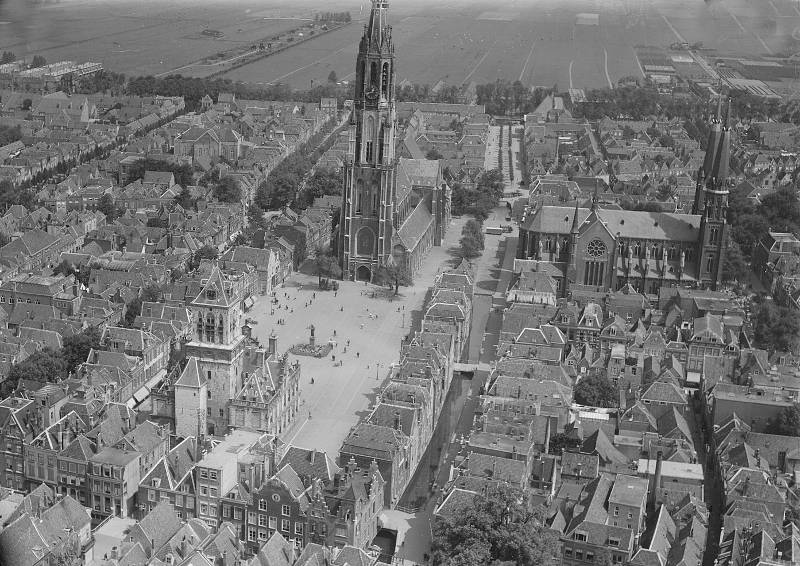 Aerial photograph of Delft
Aerial photograph of Delft from 1920 until 1940
Gelatin negative glass plate. Black and white, 13 x 18 cm.
Netherlands Institute for Military History
From its establishment, the Marktveld, which subsequently came to be known as the Grote Markt or Gootemarkt (Great Market), and now simply as Markt, has been the heart of Delft. Documentation within municipal statutes as early as the year 1246 makes mention of a weekly market on Thursday, a tradition that persists to this day, adhering to the original temporal and locational settings. The market's operations were conducted under the authority of or on the behalf of Count Willem II, where his stewards collected levies from the merchants vending their goods. The Count was also the proprietor of essential civic infrastructures such as the weigh house, called the WaagThe Delft Waag, located directly behind the Stadhuis, is currently a "two-behind-one-façade" structure. The monumental front that has been there since 1770 actually conceals two separate buildings. A drawing drawing by Jan Bulthuis shows the old situation. Inside the Waag, now a café-restaurant, this is clearly recognizable by the broken-through wall. And at the back, from the Boterbrug, it is still possible to see that the building has two roofs. (fig. 1) as well as the cloth hall, among others, which played a pivotal role in the flourishing of Delft's economy. The privilege of possessing a weighing house constituted one of the earliest urban rights accorded to Delft in the medieval period. An urban edict mandated that commodities intended for trade exceeding ten pounds in weight were to be weighed at the city's weigh house, a measure that was critical for ensuring equitable commerce, thereby reinforcing Delft's stature as a preeminent market and trading hub.
The levy, called waaggeld, was an urban excise tax, which was also a source of income for the city. The word weighing house (written in various ways as waeghe, waech, waag etc.) initially referred to a weighing instrument, but later also the weighing house where the device was located. Weighing was done with a suspended two-arm balance with two scales (from which our word scale is derived).
In 1348, the completion of Voldersgracht and Langendijk, running east-west between the Nieuwe Delft canalThe Nieuwe Delft canal runs parallel to the Oude Delft and is better known by the street names along the canal (sequentially from north to south) Voorstraat, Hippolytusbuurt, Wijnhaven, Koornmarkt, and the Korte/Lange Geer.It was dug at the end of the 19th century, approximately 100 meters east of the Oude Delft. In the north, the Old and New Delft are connected by the northern Kolk. South of the former Army Museum, near the southern Kolk, the Old and New Delft come together. and the Oosteinde canal, clearly demarcated the boundaries of Markt. This space, cradled between the StadhuisThe Stadhuis, stands at Markt opposite the Nieuwe Kerk.
The first construction of the city hall dates back to 1200. It was rebuilt or renovated in 1400. The building survived the great city fire of 1536, but on March 4, 1618, the city hall burned down. It was then rebuilt around the oldest building that Delft currently still has: a belfry called the Oude Steen, according to a design by Hendrick de Keyser in 1618-1620. Over time, the city hall was modified. The city hall is an example of Dutch Renaissance style.In side the Het Steen was located the old torture chamber and prison. (City Hall) and the Nieuwe Kerk (New Church), formed the central stage of Delft's public and economic life.
In the 1540s and 1550s, a series of imposing residences began to rise around the Markt, notably near the Nieuwe Kerk and along the Oude Delft canal,The Oude Delft is the oldest canal and street in the city of Delft, located in the Dutch province of South Holland. It runs roughly north-south and cuts through the western part of the city center. Both the north and south ends of the two canals were connected by a kolk (water-filled pit), with the northern Kolk still bearing that name. The land enclosed by the digging of the Nieuwe Delft was raised with clay and formed the basis of the city. During the Golden Age, this higher land in the swampy city center was a popular residence for wealthy merchants. Consequently, many mansions along the Oude Delft, often with the status of national monuments, are found there. as well as in other districts where many homes had been destroyed in the Great Fire.The modern history of Delft begins with the Great Fire of 1536, which destroyed the western quarters of the city. Of the two large churches that dominated the landscape, the Oude Kerk, built in the thirteenth century, was spared; but the Niuewe Kerk on the Great Markt, already about a century old, burnt halfway to the ground. Few of the wooden houses that gave the town its medieval character withstood the fire. In the next forty years, the reconstruction of the Niuewe Kerk and the building of scores of houses in brick and mortar to replace the old wooden ones absorbed the energies of citizens and drained their resources.
Historically, the Markt was the site of two significant annual fairs: one coinciding with the Delft OmmegangThe origin of this procession dates back to the Middle Ages. In 1327, a woman from The Hague, named Machteld, who had been blind for several years, had a vision one night. She was told to go to Delft to pray before the statue of Mary. After she prayed and attended the Holy Mass, she regained her sight during the consecration. Out of gratitude, it was decided to hold an annual procession, an Ommegang, in honor of Mary of Jesse. However, the Reformation brought an end to this tradition. In 1929, this tribute to Mary was restored by a group of young people, members of the student association Sanctus Virgilius. Since then, every year on the Sunday following the feast of St. Odulfus (June 12), many people from Delft and the surrounding area participate in this procession, which - unlike in the Middle Ages - is now conducted in silence and has taken on a meditative character. In June 2007, the Ommegang was once again held on Sunday, June 17; the leader was Pastor Tjeerd Visser. The theme was: "Delft, City of Mary." —a traditional procession held annually on June 12, the feast day of Saint OdulphusSaint Odulphus (or Odulf) is a lesser-known saint in the Roman Catholic tradition, particularly revered in the Netherlands. The details of his life are somewhat scarce and mixed with legend, but it is believed that he also contributed to the establishment of monasteries and churches in the area. After his death, he was venerated as a saint, and his relics became objects of devotion. Saint Odulphus's feast day is an opportunity for local parishes and communities to reflect on their Christian heritage and the history of Christianity in the region. It might be marked by special church services, processions, or other community gatherings, though these would be relatively modest compared to more widely recognized saints' days. —and the other on the feast day of Saint Eligius, which falls on December 1. The square also bore witness to public executions, a sobering reminder of its multifaceted role in civic affairs. Prior to the erection of the Nieuwe Kerk, the eastern segment of the Markt was designated as a gallows field, a testament to its function as a place of ultimate justice in bygone eras.
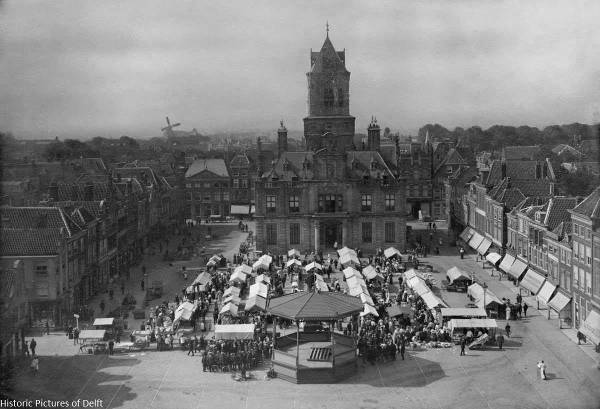 Markt, Delft
Markt, Delftc. 1911
For the construction of the Nieuwe Kerk, the Markt was shortened by about thirty-four meters in 1396. In 1421, another strip of seventeen meters was given up to serve as a cemetery. In 1436, Count Philip the Good donated his manorial court and the remaining Markt to the city of Delft. The buildings of the manorial court were used as the Stadhuis from that moment on. The Markt was paved for the first time in 1484, and the well that had always been there disappeared. On that occasion, the site was raised by ninety centimeters, using the manure surplus from the surrounding area.Markt (Delft), Wikipedia
The middle classes, including trained craftspeople, lived around the places where trade was carried out, such as the Markt, while the town's elite lived in beautiful buildings on Oude Delft, the most prestigious canal in the city. The poorer inhabitants of the city lived in small dwellings behind houses along a canal, such as Vlamingstraat. While specific historical details about Vlamingstraat might not be as widely documented or known as those of more famous locations in Delft, streets like Vlamingstraat contribute to the overall historical and architectural character of the city. Streets in Delft often have historical and cultural significance. They may be named after notable figures, events, or aspects of the city’s history. "Vlaming" typically refers to someone from Flanders, indicating possible historical connections with that region. The latter group were usually dependent on charity, such as meted out by the Kamer van
Charitate (Chamber of Charity).In 17th century Delft, the poorer population often lived in small dwellings behind canal-side houses, like those on Vlamingstraat, and were reliant on charity. The Chamber of Charity, established in 1597 by city governors, played a key role in supporting the poor. Operating from Schoolstraat near the Prinsenhof, the Chamber distributed essentials like bread, turf, clothing, and sometimes money. Notably, the Chamber was led by painter Cornelis de Man, who in 1682 crafted an artwork for the governors' room, depicting an angel distributing specially baked square loaves marked with a 'C'. Charity notes were required for distribution. During this time, 11 to 15 percent of Delft households regularly depended on charity, often due to financial difficulties or the loss of a family breadwinner. Many poor were women whose husbands were absent for long periods, serving in the Dutch States Army or with the East India Company. Johannes Vermeer, a notable inhabitant of Delft, benefitted from the financial stability provided by his mother-in-law, a circumstance not shared by many others in the city. David de Haan, Arthur K. Wheelock Jr., Babs van Eijk, and Ingrid van der Vlis, Vermeer's Delft (Zwolle: Waanders Uitgevers, Museum Prinsenhof Delft, 2023), 83.
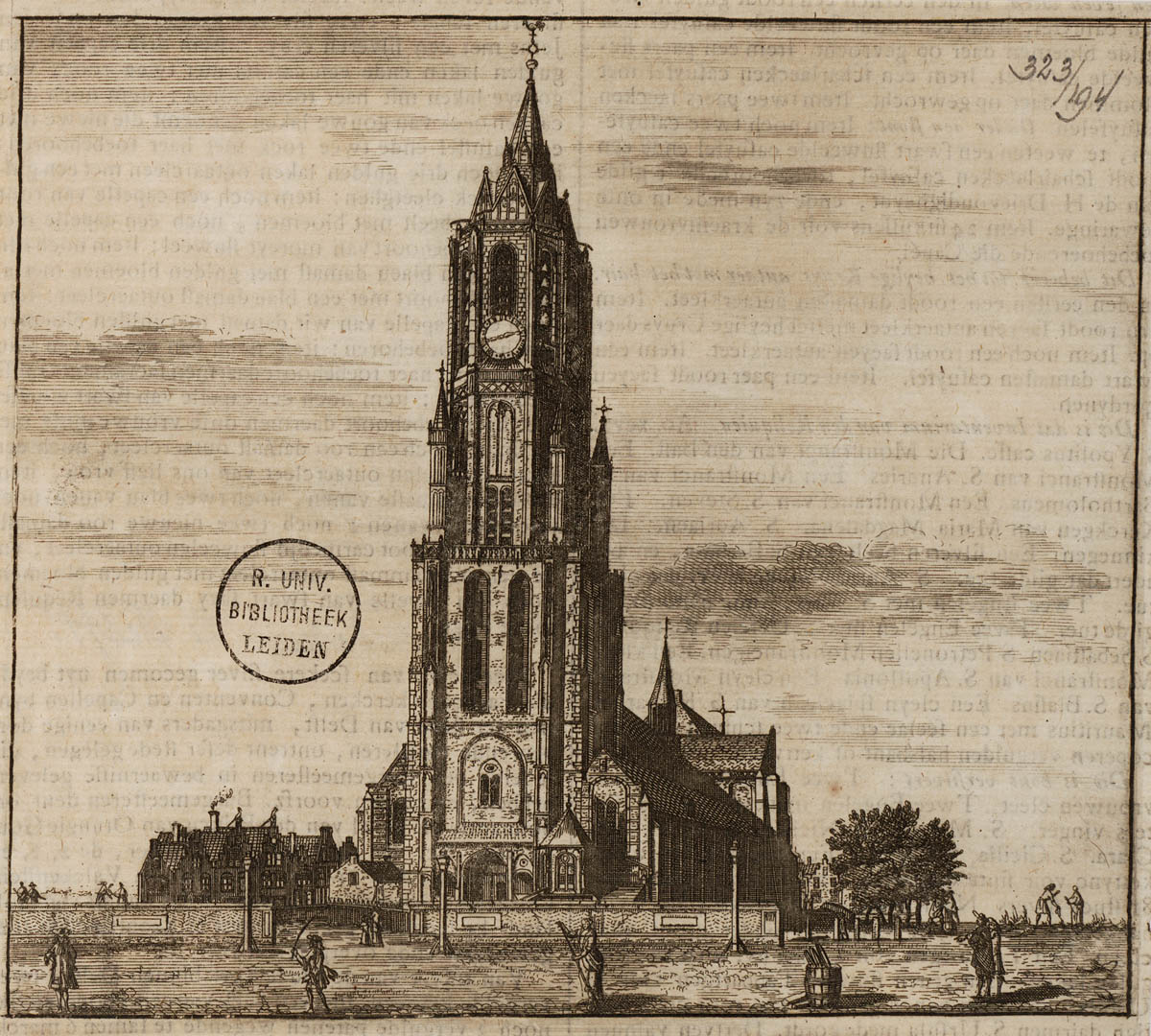 Groote Kerk in Delft, Delft
Groote Kerk in Delft, DelftCoenraet Decker
1667
Engraving on paper, 33 x 26.7 cm.
Topografie van Nederland, Universiteitsbibliotheek Leiden
The Nieuwe Kerk , which reached its current size in 1510, was initially flanked by two rows of houses that had previously formed the boundary of the Markt. The cemetery was therefore particularly small. To expand it, the southern row of houses was demolished around 1493. This gave Markt the boundaries it still has today.
During a repaving in 1595, a compass rose was installed in the paving. A statue of Hugo Grotius (1583–1645)The bronze statue of Hugo Grotius which sits on Markt square in front of the Nieuwe Kerk was created by Franciscus Leonardus Stracke in 1886. was placed on this compass rose in 1886 .
Over the centuries, there has usually been some kind of separation between the cemetery and the Market in front of the church. Until around 1702 this was a wall. Later, when its function as a cemetery disappeared, it was a row of trees, the last remains of which disappeared around 1930. Before the redevelopment in 2004, an archaeological investigation was carried out into the cemetery. This showed that the cemetery extended on both sides up to three meters from the facades of the houses on the Market. To the south, the burials continued further than expected, but the boundary could not be determined.
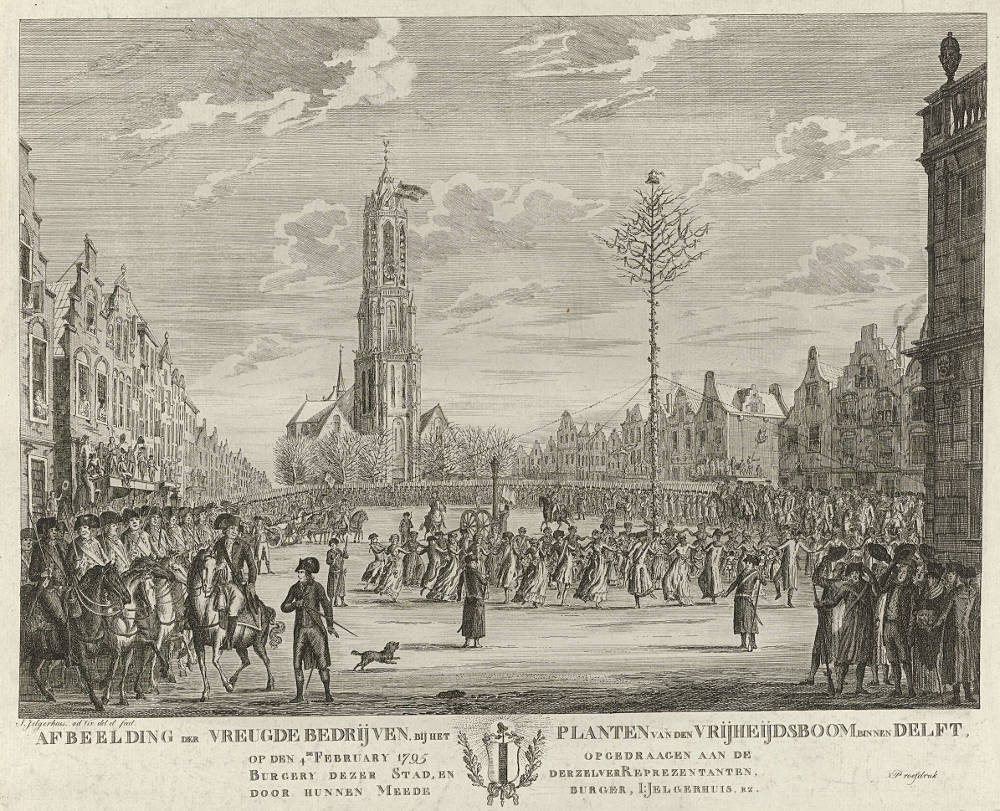 Celebration at the Planting of the Liberty Tree in Delft, 1795
Celebration at the Planting of the Liberty Tree in Delft, 1795Jelgerhuis, Johannes
1795–1797
Engraving on paper, 33.5 x 41.7 cm
Rijksmuseum, Amsterdam
Other than its topography, architectural evolution and practical function, the Markt had been the site of elaborately-staged pageants, solemn funerals, brutal, executions, and impromptu uprisings.
The burials in the cemetery in front of the Nieuwe Kerk reflected the constant presence of death in the seventeenth century, which was a visible part of daily life due to high rates of infant mortality and maternal deaths during childbirth. "Living by the canal was not without its hazards. There were no railings along the canal, as the quays were used for loading and unloading cargo from boats. In the seventeenth century, it was therefore not at all uncommon for adults and children to drown in the many waterways running through Delft. This was a fate that befell crewmembers of the ships that visited the city, but pedestrians would also frequently fall into the water—accidents even happened with water butts at home. The city’s physicians kept notes of the autopsies they performed, so we can read that, also in the 1630s, many adults and children were 'overcome by water.'"Ingrid van der Vlis et. al., "In the Footsteps of Vermeer ," in Vermeer's Delft, edited by David de Haan, Arthur K. Wheelock Jr., Babs van Eijk, and Ingrid van der Vlis (Zwolle: Waanders Uitgevers, Museum Prinsenhof Delft, 2023), 122.
Situated across the square, the city hall was the seat of governance and justice. Here, punishments such as public humiliation in stocks, floggings, and even executions were carried out, often in full view of the town's population. Thus, the Markt was not only a center for civic activities but also a place where the cycle of life and death was prominently displayed.
Vermeer and the Markt
 fig. 2 Gesigt van de Groote Markt tot Delft siende naar het Stadthuys, Oude en Nieuwe Kerk
fig. 2 Gesigt van de Groote Markt tot Delft siende naar het Stadthuys, Oude en Nieuwe KerkLeonard Schenk after Abraham Rademaker
c. 1730
Engraving on paper, 57 x 98 cm.
Delft, Delft archief
On April 23, 1641, Vermeer's father, Reynier Jansz. Vos, bought a large and heavily mortgaged inn on the Markt called Mechelen.Originally n amed "Herberg Mechelen," Mechelen was run as an inn by Johannes' father. The original building no longer exists; it was demolished in 1885 by the City of Delft to allow for the widening of the access route to the Markt, which also involved the construction of a new bridge to improve traffic flow from Voldersgracht. The former narrow alleyway was transformed into a more accessible road. Interestingly, remnants of the inn were uncovered during an archaeological survey in 2019, revealing its foundations about 40 centimeters below the surface. He paid two hundred guilders in cash and assumed two mortgages, totaling 2,500 guilders. With four fireplaces, Mechelen was indicative of its size as one of the Markt's largest buildings. It was on the corner with the Oude Manhuissteeg (Old Men's Alley),Opposite this alley and bridge, the Oude Mannenhuis (Old Men's House) was located on the Voldersgracht from 1411. This institution consisted of a number of rooms or houses around a courtyard and a chapel. From the middle of the 17th century, it was used as the Sint-Lucasgildehuis (Guild of Saint Luke House). The entire complex was demolished in 1876 for the construction of a primary school, and it was reconstructed in 2007." a narrow alleyway that led to the Voldersgracht via a small bridge (Oudemanhuisbrug). In an engraving by Leon Schenk after Abraham Rademaker, (fig. 2) Oude Manhuissteeg can be seen in front of the row of trees, the site of Mechelen, the house where Vermeer grew up, is on the corner to the left.Nothing remains of the seventeenth-century inn. In 1885, the City of Delft had the building demolished to widen access to the Markt. This allowed traffic from Voldersgracht to access the Markt more conveniently via a new, wider, and lower bridge. Prior to this, Oude Manhuissteeg had been a narrow alleyway, not exceeding two meters in width.
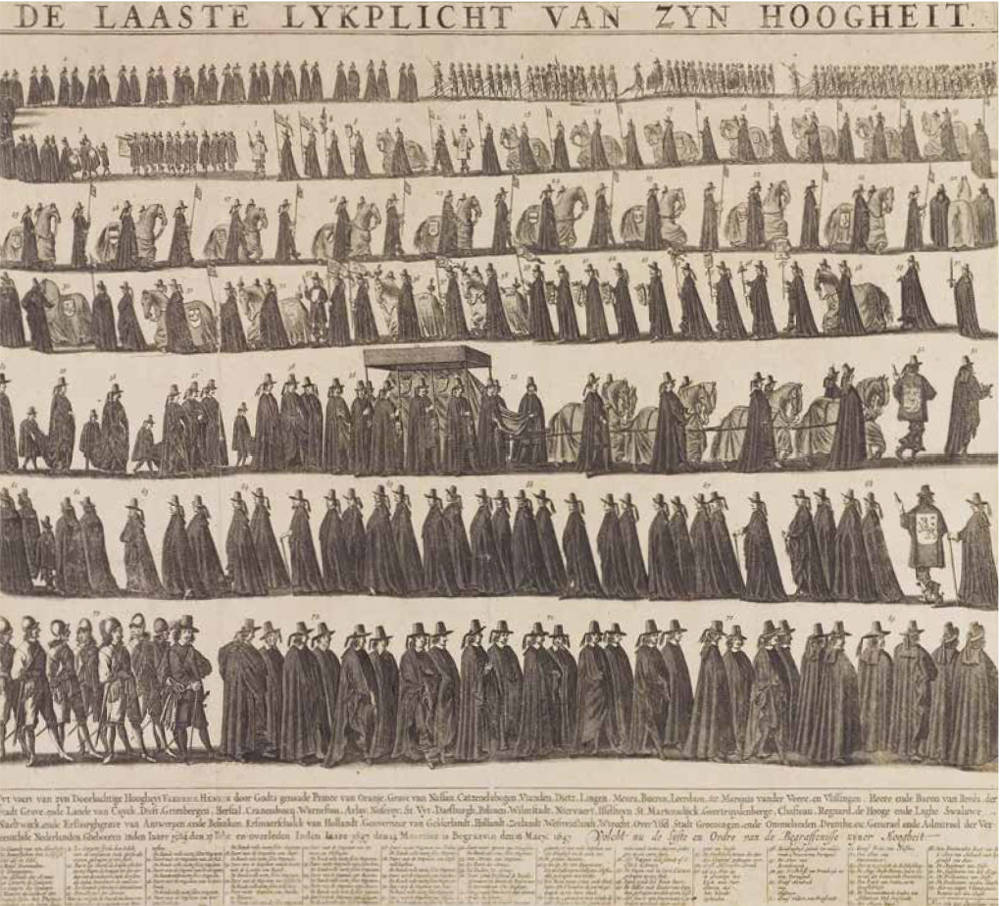 fig. 3 Funeral Procession of Frederik Hendrik in Delft, May 1647
fig. 3 Funeral Procession of Frederik Hendrik in Delft, May 16471650–1652
Engraving paper, 11 x 13 cm.
City Archives Delft, Delft
Johannes Vermeer’s life would take place largely on and around the Markt. From the front of Mechelen, the future painter and his family could have observed many of the most important events that took place in Delft. Outside the doors and windows of Mechelen, "one has a clear view of the entire Markt, stretching from the Nieuwe Kerk church to the city hall. These two prominent buildings still maintain much of their appearance from Vermeer's time, although back then, there was still a churchyard surrounding the Nieuwe Kerk. Burials occurred nearly up to the inn's front door. In the seventeenth century, death was a constant presence and, in part, an observable aspect of everyday life. Infant mortality and deaths during childbirth were alarmingly high. Moreover, death manifested itself in various ways on the Markt: across the square stands the city hall, where city officials convened and justice was administered. Convicts faced public humiliation in the stocks, and floggings were a regular occurrence. Occasionally, the entire town would assemble to witness a public execution." Ingrid van der Vlis et. al. , "In the Footsteps of Vermeer ," in Vermeer's Delft, edited by David de Haan, Arthur K. Wheelock Jr., Babs van Eijk, and Ingrid van der Vlis (Zwolle: Waanders Uitgevers, Museum Prinsenhof Delft, 2023), 126. On May 1647, Vermeer was fourteen years old when Stadtholder Frederick Henry, Prince of Orange (1584–1647) died. The prince's burial took place with great pomp and ceremony in the Nieuwe Kerk (fig. 3) . The Vermeers would have had a front-seat view of the spectacle from Mechelen.
Delft's Markets
from: Hillege, Marjolein. "Markt Delft: Herinrichting Plein." In Marjolein Hillege: Landscape and Film. Accessed December 20, 2023. https://www.marjoleinhillege.nl/portfolio/grote-markt-delft/.
It is easy to assume that the Markt was Delft's sole marketplace. However, a stroll through Delft reveals a different story, as evidenced by street names like Koornmarkt (Grain Market), Brabantse Turfmarkt (Brabant Peat Market), Paardenmarkt (Horse Market), and Beestenmarkt (Cattle Market).
Historically, many streets were named after the specific goods traded there. This is evident in names like Appelmarkt (Apple Market) on the east side of Vrouwjuttenland, the two Houtmarkten (Wood Markets) at Kolk and the west side of Koornmarkt, Luizenmarkt for second-hand clothes on the west side of Vrouwjuttenland, Zuivelmarkt (Dairy Market) on the east side of Koornmarkt, and Varkenmarkt (Pig Market) near Verwersdijk at Cellebroerstraat.
On the east side of Voorstraat, between Choorstraat and Drie Akersstraat, lay the Poelmarkt, a market specializing in poultry such as ducks and geese. It extended over to Kerkstraat via the appropriately named Poelbrug (Pool Bridge). Bridges were commonly used as trading places. The most famous is the Boterbrug (Butter Bridge), actually an overvaulted canal where more than just butter was traded. Older residents of Delft might remember it as a market for small livestock like chickens and rabbits. On the Teemsbrug at the south side of Wijnhaven, you could buy a '"teems," a funnel with a sieve for pouring freshly milked milk into a container. And on the north side of Wijnhaven lies Warmoesbrug, where vegetable sellers traded their goods.
The naming of Camaretten and the east side of Hippolytusbuurt as Vismarkt (Fish Market) makes sense, especially considering the enduring Visbanken (Fish Banks), a traditional hub for sea fish trade. For freshwater fish, the city council designated Jeronymusbrug in 1584. Located opposite Nieuwstraat, it is named after the Sint-Hiëronymusdal, the house of the Brothers of the Common Life on the west side of Oude Delft. A historical drawing, likely made shortly after this designation, illustrates why a bridge served as an ideal location for a fish market. Sellers sit on both sides, with their baskets of fish above a gutter. They can occasionally fetch a bucket of water from the canal to pour over the fish to keep it fresh. The water flows back to the canal through the gutters in an arc.
Some Markt Facts
- One of the first decrees issued by Willem the Silent, who elected to move his court to Delft after the Alteration, banned all public processions. The candlelit marches around the Markt and the Nieuwe Kerk were never to be revived.
- To the northwest of the Markt, in a separate square and directly across the Oude Delft from the Prinsenhof, William the Silent was assassinated on July 10, 1584.
- In the seventeenth century, Vermeer and his family moved to Huis Mechelen, an inn his father purchased in 1641, located in Delft. Situated near Voldersgracht on the Market Square, the inn was conveniently less than a hundred meters away via Oude Manhuissteeg. Named 'Herberg Mechelen,' it was run as an inn by Johannes' father. The original building no longer exists; it was demolished in 1885 by the City of Delft to allow for the widening of the access route to the Market Square, which also involved constructing a new bridge to improve traffic flow from Voldersgracht. The former narrow alleyway was transformed into a more accessible road. Interestingly, remnants of the inn were uncovered during an archaeological survey in 2019, revealing its foundations about 40 centimeters below the surface.
- In the seventeenth century, the Markt was a commercial and residential hub for the city's burghers, with many owning workshops and shops on the ground floor and living quarters upstairs. The presence of fold-out shutters on buildings, as seen in seventeenth-century prints, allowed tradesmen to display their goods under an awning. While not the wealthiest part of the city, it was home to many well-to-do citizens who could afford luxuries like paintings.
- The Nieuwe Kerk, which dominates the Markt, has played an important role for the residents of Delft over time. Royal burials of deceased kings, queens, princes, and princesses took place there. These were sad days for the royal families but a spectacle of great public interest. Seats were rented out on a special stand, built by the owners of buildings overlooking the Markt.
- On September 20, 1625, a long funeral procession passed across the Delft Market in the direction of the Nieuwe Kerk. It was the funeral of Prince Maurits, who died on April 23, 1625. The stadtholder's embalmed corpse was stored in The Hague until it was transported to Delft in a black-clothed barge on September 16. There it stayed in the Prinsenhof until the funeral on September 20. The burial was a very costly affair. The bier carrying the Prince's corpse was preceded by eight halberdiers with their weapons pointed downward. Senior officers from the State army surrounded the box, draped with a cloth decorated with Maurice's weapons. Family members, including Frederik Hendrik, followed behind the cavalry's rhythm masters. Close to them were the Winter King Frederick V and his retinue, followed by the counts of Nassau. The ambassadors of France and Venice were closely involved, followed by pages and lackeys, who were less in line than the other participants. The last part of the procession consisted of members of the States General and the Council of State, followed by representatives of regional and urban authorities. For example, almost 12,000 guilders were spent on the mourning clothes of the members of the royal household. Prince Maurits, the second son of Prince William of Orange, died of liver cancer on April 13, 1625.
- In front of the Nieuwe Kerk throughout the centuries, there was usually some kind of separation between the churchyard and the Markt, which, until around 1702, was a small wall. Later, when the function of the churchyard disappeared, it was transformed into a row of trees, the last remnants of which disappeared around 1930. Before the redesign of 2004, an archaeological investigation was conducted on the churchyard. It revealed that the churchyard extended to both sides up to three meters from the facades of the houses beside the Market. The graves to the south extended further than expected, but the boundary could not be determined.
- On May 10, 1647, the young Vermeer may have witnessed the funeral of Frederick Henry in the Nieuwe Kerk, on Markt.
- In 1650, there were riots in Delft on the occasion when Prince William II came to "displace" the town council. Tromp was buried with great solemnity in the Oude Kerk.
- In 1661, Vermeer must have listened to the first playing of the new carillon, made by the Hemony brothers for the tower of the Nieuwe Kerk. The work of the Hemony brothers is considered a high point in the art of bell founding, and their carillons, including the one in the Nieuwe Kerk in Delft, are treasured as both historical artifacts and functioning musical instruments.
- In 1662, there was a great stir when the three murderers of Charles of England were caught in Delft. These are the occurrences which for a few moments brightened or disturbed the daily life of the citizen.
- King Charles II of England visited Delft on May 25, 1660. This event was significant enough that Johannes Vermeer was present to witness the king's entry into the city.
- Nearby the Markt, although no longer active, were Delft's historical markets, the Beestenmarkt, Paardenmarkt, Brabantse Turfmarkt, Warmoesbrug, and Boterbrug, pointing to the trade of livestock, horses, turf, vegetables, and butter, respectively. At the entrance of Voldersgracht lies de Cameretten, a small square where remnants of the old market pitches still exist. The Vleeshal, or meat hall, now known as Koornbeurs, was the exclusive location for butchers to sell their meat; it is noted for having had real animal horns on the building and trellis in the windows for ventilation. Adjacent to the Vleeshal were the Visbanken, or fish stalls, where sea fish were sold, while freshwater fish were available at a weekly market on a bridge at the end of Nieuwstraat.
-
Pieter van Ruijven, who together with his wife Maria de Knuijt collected Vermeer's painting assiduously, passed away in August of 1674 at the age of just forty-nine. Following Van Ruijven's death, De Knuijt passed away in February of 1681. In early April 1680, their only daughter, twenty-four-year-old Magdalena, married Jacob Dissius, the son of the owners of the Het Gulden ABC (The Golden ABC) printing house located on the Markt.
Unfortunately, their marriage was short-lived as Magdalena, the young wife, passed away just two years later in June 1682, presumably due to childbirth. Interestingly, after her death, no fewer than twenty paintings by Vermeer were recorded in the estate inventory that her husband had drawn up in April 1683. These paintings accounted for half of the collection of paintings in their house on the Markt.
- In 1743, Abraham de Haan drew a fine image of the Markt. Stately houses lined the spacious square between the Nieuwe Kerk and the town hall. Under the tree hedge in front of the church stood a carriage with two horses. Shopkeepers displayed their goods, and business deals were made or conversations held under their awnings. Among the barrels and bales, people strolled, while others bought snacks at the stall against the town hall. The Markt was the lively and at the same time cozy center of a distinguished city."The Marktveld to Markt," Erfgoed Delft & Stadsarchief Delft, May 2023, accessed December 19, 2023, https://www.stadsarchiefdelft.nl/delft365/van-marktveld-tot-markt/.
- With the redesign of 2004, a new row of trees was planted in front of the church, and a new compass rose was laid out. The statue of Hugo de Groot was thoroughly restored and returned to a new location, off-center and closer to the Nieuwe Kerk. Interestingly, during a royal funeral, the royal guests cross the Markt from the City Hall, and now they no longer need to walk around the statuee.
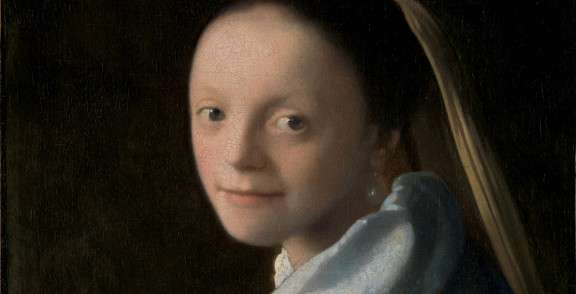



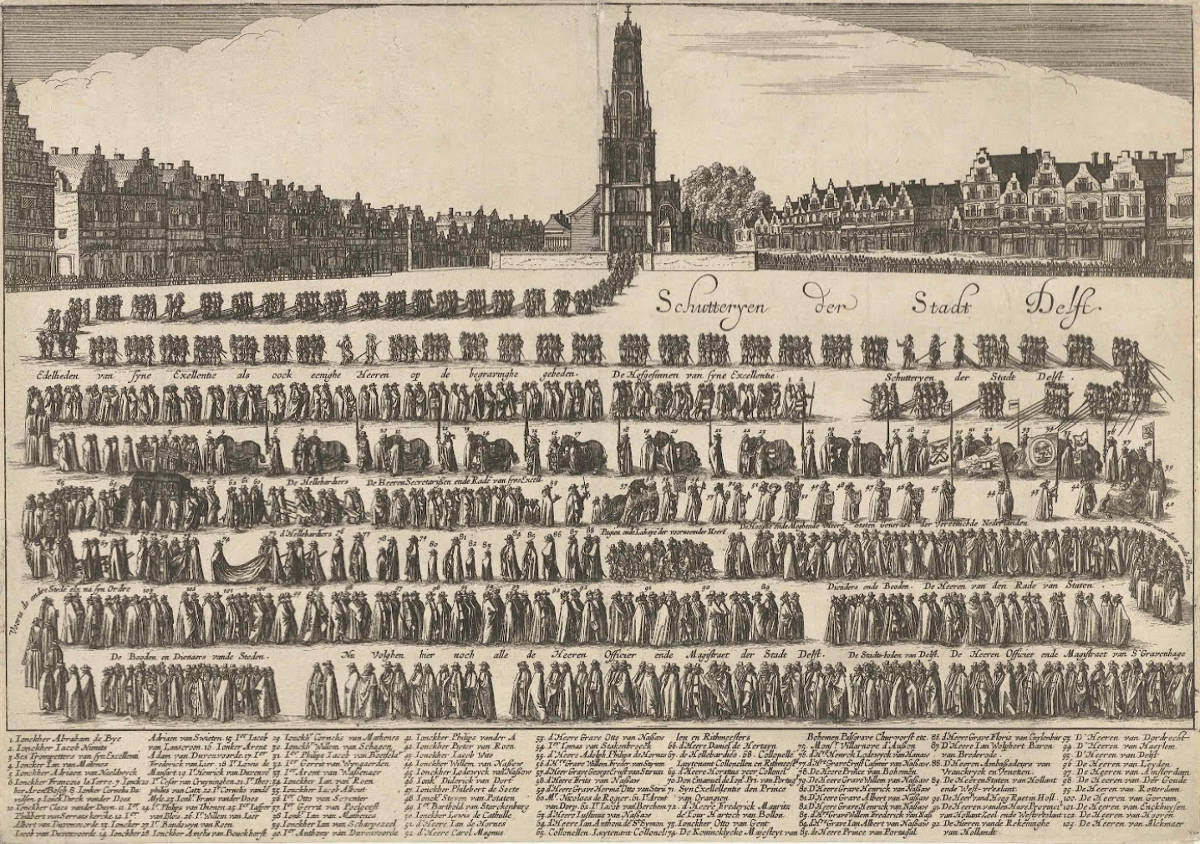

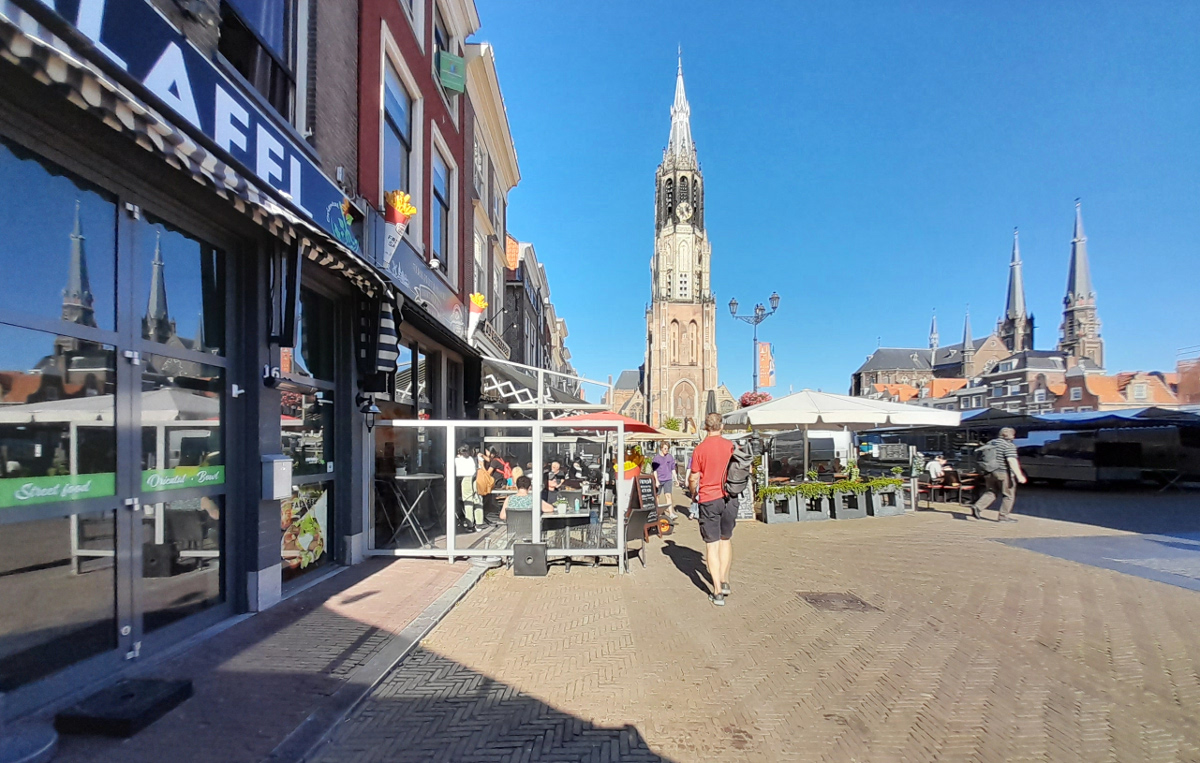
 or anything else that isn't working as it should be, I'd love to hear it! Please write me at:
or anything else that isn't working as it should be, I'd love to hear it! Please write me at: